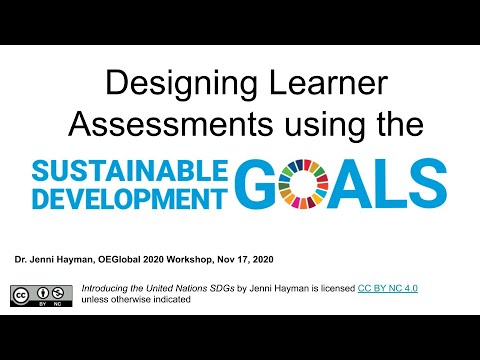Author: Jenni Hayman
Institution: Cambrian College, Sudbury, Ontario, Canada
Country: Canada
Topic: Applications of Open Education Practices/Open Pedagogy/Open Education Research
Sector: Higher Education
UNESCO Area of Focus: Building capacity
Session Format: Workshop
Abstract
Approximately two million learners were enrolled in post-secondary institutions in Canada in the 2016/2017 academic year (Statistics Canada, 2018). That number is likely relatively similar for 2019/2020. If each of those learners were enrolled in 3 courses per semester, and each course required one hour of homework and assignment time per week (over 15 weeks) that’s a total of 90 million hours of potential learner co-creation of knowledge. Just in Canada, just in one semester. Using David Wiley’s idea of reducing “throw away assignments” that are never used after grading (Wiley, 2013), the United Nations Sustainability Goals (SDGs) present a fantastic opportunity to design and assign globally relevant and experiential projects as part of post-secondary and other human learning experiences (e.g., PreK-12, training and development, and community education).When educators and administrators discuss the concept of scaling up education, learner. homework hours rarely enter into the conversation. Many institutions look to technology, digital textbook practice problems, massiveness, adaptiveness, VR, AR, AI, and digital solutions as trends (Brooks and McCormack, 2019; James, n.d). Educators and administrators often fail to see the extraordinary potential of human resources right in front of them. Audrey Watters (2018) continues to act as a canary in the education coal mine about educational technology and the rhetoric of scale, fighting against statements such as, “Higher education’s biggest concerns are converging with technology’s greatest capabilities “(Brooks and McCormack, 2019, para. 2). Educators may be missing some key learner opportunities, non-technological in origin to address global concerns.
It is in the exceptional human capabilities of learners where hope resides for critical thinking and problem solving. In terms of scale, global learners are our best possibility to even come close to achieving the 2030 Sustainable Development Goals (https://sustainabledevelopment.un.org/#). However, in order for post-secondary learners to provide ideas and leadership on solving the wicked problems outlined in the SDGs, they need opportunities for practice through assignments and projects in their program contexts.
The purpose of this interactive workshop is for participants to learn about the SDGs (if they have not yet heard of them) (UNESCO, n.d.), and explore with each other and the facilitator how to use the topics, targets, and indicators listed within the SDGs to develop curriculum in the form of assignments and rubrics for learners.
References
Brooks, D. C., & McCormack, M. (January 28, 2019). Higher Education’s 2019 Trend Watch & Top 10 Strategic Technologies [online report]. Retrieved from https://library.educause.edu/resources/2019/1/higher-educations-2019-trend-watch-and-top-10-strategic-technologies
James, K. (n.d.). Education Trends to Watch in 2019 [online article]. MDR Education. Retrieved from https://mdreducation.com/2019/02/13/education-trends-2019/
Statistics Canada. (November 28, 2018). Canadian postsecondary enrolments and graduates, 2016/2017. Retrieved from https://www150.statcan.gc.ca/n1/daily-quotidien/181128/dq181128c-eng.htm
United Nations. (n.d.). Sustainable Development Goals Knowledge Platform [webpage]. Retrieved from https://sustainabledevelopment.un.org/?menu=1300
Watters, A. (December 18, 2018). The Stories We Were Told about Education Technology (2018) [blog post]. Retrieved from http://hackeducation.com/2018/12/18/top-ed-tech-trends-stories
Wiley, D. (2013). What is Open Pedagogy? [blog post]. Retrieved from https://opencontent.org/blog/archives/2975
Keywords
Open Educational Practices, Sustainable Development Goals, Assessment
